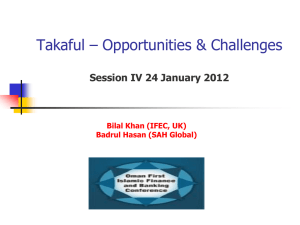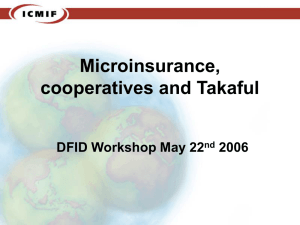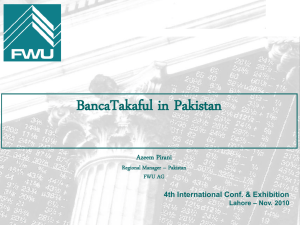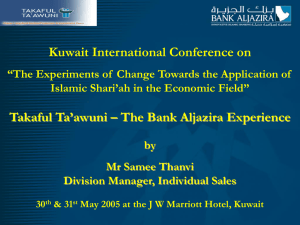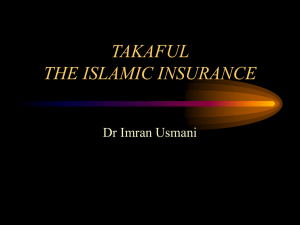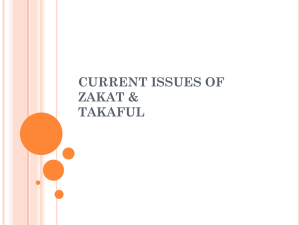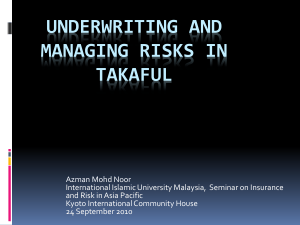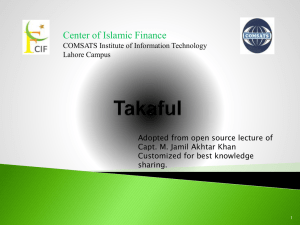3 Retakaful at Swiss Re
advertisement
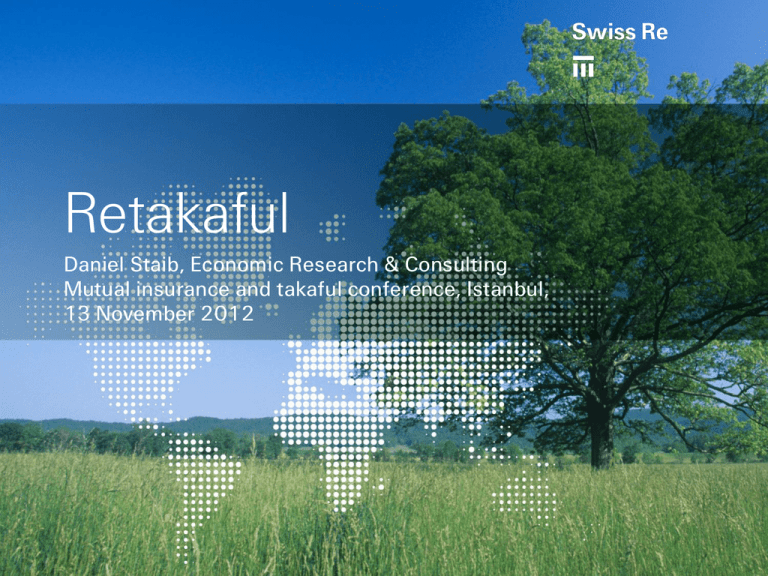
Retakaful Daniel Staib, Economic Research & Consulting Mutual insurance and takaful conference, Istanbul, 13 November 2012 Table of contents 1. 2. 3. Market potential & outlook Retakaful at Swiss Re Operating model (Wakalah-Waqf) Challenges in retakaful 2 2 Market potential & outlook 3 2 Market potential & outlook 25% of world population is Muslim (1.5 bn people). In addition, Takaful is also an attractive solution to non-Muslims. Market premium written in Muslim countries (2010): USD 73bn. Islamic insurance premium (2010): USD 3.2 bn (takaful) + USD 4.0bn (cooperative model – KSA) + USD 5.1bn (conventional insurance within Islamic financial system): Total: USD 12.3bn. Low level of insurance penetration compared to other emerging markets. Population of Muslim countries are rapidly growing; favourable demographics. Increasing Islamic consciousness. Growth of Takaful has been exceptional over past four years (almost 30% p.a.), but is expected to slow in 2012 Until 2015 Takaful contribution could surpass USD 7bn. 4 2 Takaful contributions by country 2010: USD 3.2 bn Malaysia is leading in terms of size and development of its takaful markets Assumptions: Muslim countries only only included if written on the basis of wakalah, mudarabah or hybrid models Bahrain 3% United Arab Emirates 12% Malaysia Other Middle East 12% Business Indonesia 13% Other South East Asia 8% Saudi Arabia Malaysia 31% Sudan Other South East Asia Indonesia Saudi Arabia Sudan 12% 9% United Arab Emirates Bahrain Other Middle East Source: Swiss Re Economic Research & Consulting 5 3 Retakaful at Swiss Re 6 Operating Model: Wakala-Waqf Fund Participants (e.g. AIA Takaful) Investment Income Profit Sharing Basis Qard (Re)takaful Operator Wakalah Fees Initial Donation Contributions Claims/surplus distribution (unconditional donation) Tabarru part: Mutual Pool for collection of contributions, payments and claims & setting up of stabilisation reserves Cash Waqf Slide 7 7 3 Characteristics of the Wakalah-Waqf Model Swiss Re’s WakalahWaqf model has been accepted by Accounting and Auditing Organization for Islamic Financial Institutions (AAOIFI), the National Shari’a Advisory Council (SAC) of Bank Negara Malaysia, and National Syariah Council, Indonesia. Wakalah-Waqf model is used in Pakistan, South Africa and the Middle East Initial donation to set up fund: USD 5’500/MYR 20’000 Swiss Re has set up various funds based on geographical location and lines of business covered. Waqf agreement: 1. Application to become member of fund 2. Acceptance as member of fund 3. Fund rules (same for all members) 4. Applicable wording (Retakaful Agreement): General/Special Conditions Swiss Re’s commitment to the fund: 1. To ensure that overall results are not influenced by large individual negative results 2. In case there are insufficient funds to pay claims, Swiss Re will provide an interest free loan (Qard) 8 3 Characteristics of the WakalahWaqf Model Investment of fund in Shari'a compliant relatively liquid assets investment income will remain part of fund: SR does not get share of investment income Operator is paid a fee (Wakalah fee) out of the Waqf fund All contracts ending in the same financial year of the Operator are pooled together to calculate the surplus Surplus given back to participant is apportioned between participants in relation to their surplus contribution (i.e. based on technical result) No incentive fee for the Operator Same operating model used worldwide. Swiss Re Retakaful ensures complete Shari’a compliance through: – No conventional retrocession – Only Takaful business ceded into the funds 9 4 Challenges in retakaful 10 Challenges in retakaful No global regulatory framework Diversity of industry practises Recent lack of growth of business Price pressure from cedent companies How to handle large commercial risks 11 Thank you
